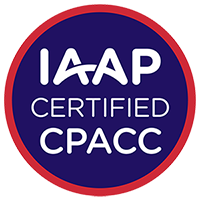Inclusive Design Considerations
Giving attention to these elements will make your website more functional to all, and especially to those who are using assistive technology or who may have physical or sensory challenges. All visitors get a better experience and some of these features can improve your search engine rankings.
Keyboard functionality
Visitors using a screen reader navigate with a keyboard as well as those who cannot physically maneuver a mouse or touchpad. Try tabbing through your page using just the keyboard. The focus should move in a logical fashion through the page.
Color contrast
When choosing your color scheme, carefully consider the contrast of the foreground (the text) and the background. There are a variety of online tools that allow you to check the color contrast on your website. Those with low vision or color blindness may not be able to decipher a page with poor contrast.
Font and scalability
Choose a font that fits your brand and is easy to read, with the optimum size determined by the color contrast as described above. If your color contrast is lower, use a larger text size. Be sure to enable scalability so visitors with low vision can resize all of the text on the page up to 200%.
Alt text descriptions for images
This is hidden text that briefly describes the image. It will be read aloud by a screen reader. Some browsers may display the alt text if the image cannot be loaded. An added benefit is that this information can be read by search engines.
Captions for video content
Text that is overlaid on a video to include spoken dialogue and sound effects will engage the Deaf and Hard of Hearing audience. Many people may choose to use captions for other reasons.
Descriptions for audio content
Audio description is a narration track to accompany a video that will provide information about visual content to blind and visually impaired users.

